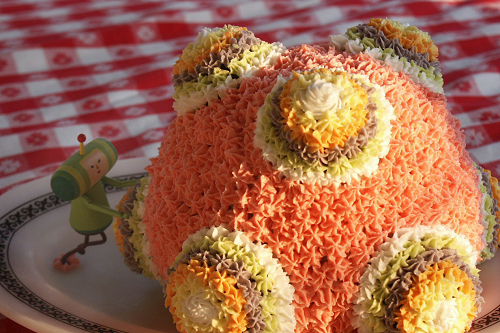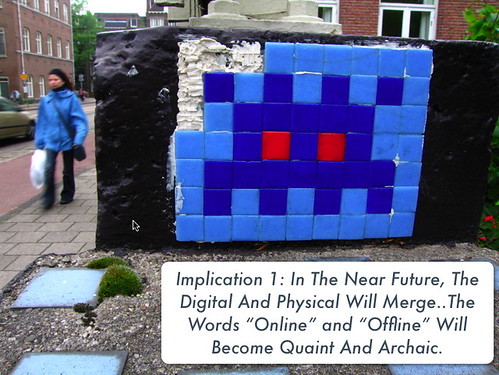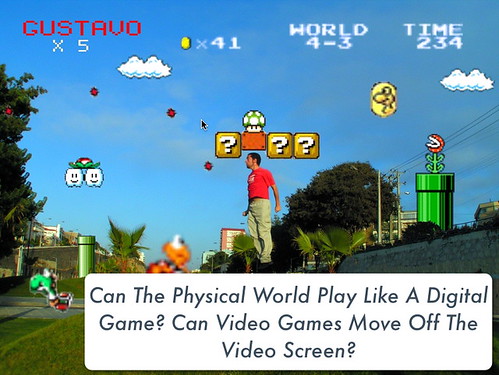
http://www.flickr.com/photos/guatevino/
We had a short little discussion after the Blur + Sharpen Machinima screening the other night. The screening was an hour of Machinima, a genre of visual story telling that uses video game stylings and form — especially the graphics and play dynamics “engine” — to produce the story experience.
I started to think about this genre in relation to a presentation I gave recently on some insights into video games expressed in real world settings. It was a sort of brief on weak signals related to the increasing over flow of video game idioms into first life. Characters, graphics, game logic, game speak — find their way into practices beyond the video screen into the real world. I find this fascinating, largely because of this vector away from exclusively sedentary, desktop/screen/keyboard/mouse-based experiences towards ones that integrate the “real world” with digitally networked social practices. There’s also the manner in which these idioms appear — very similar in my mind to what you might call an inversion of the usual Machinima production. Video games appear as overlays with the real world serving as the “engine” for the experience. This happens in a diversity of ways — “Photoshopped” images, costumes, cakes..
http://www.flickr.com/photos/thesingingleaf/
In relationship to Machinima, I began to see the various bits of material such as this as a kind of inverse of the Machinima genre: instead of turning the video game mise en scène into a stage for showing a visual story, the real world is visualized as a setting that draws from video games.
The question is this: What are the near future possibilities of mixing and blending first life props, actions, movements, proximity relationships, time (especially time factors) into the core of what counts as the user interface? The canonical (and quite ancient, in digital technology terms) keyboard-video-mouse configuration that Douglas Englebart applied for in 1967(!) is perhaps ready for an evolution. This particular screen-keys-mouse-stick-thing arrangement frames very particular kinds of interactions that are suitable largely for sitting still and twiddling. Despite their fascinating and suggestive possibilities, touch interfaces and “mobile” computing do not in my opinion go terribly far beyond this, at least in terms of any new kinds of interaction practices. Things like location and proximity are beginning to creep into the interface space, as are motion and such things like this.
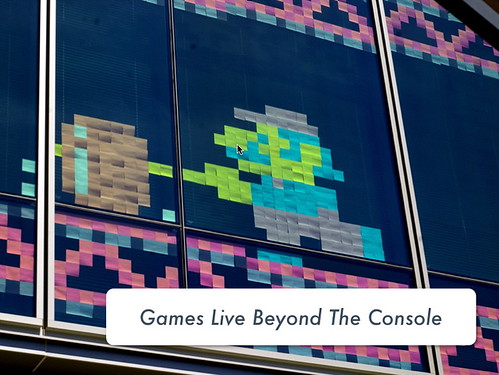
http://www.flickr.com/photos/rsdio

http://www.flickr.com/photos/inoneear/
The “fan culture” of some of these more popular games, you find this expression of the game in other realms. People want to continue with the game beyond just the console, and have their “friends” within the game carry on with them in other contexts.
In some situations you can clearly see how the game imaginary and fiction lives just below the surface — especially when fans start seeing indications of the game world imprinting itself on real world objects. In this case, this fan saw this and tagged it as a Donkey Kong structure rather than a simple scaffold. It may indeed be both, or just a Donkey Kong apparatus — it would certainly possibly work as both if a context were available for it to be “played” as a Donkey Kong apparatus. Perhaps finding scaffolds in the real world is part of an extended, first-life Donkey Kong game — the scaffold means you get to pursue the princess up another level when you get back to your computer. Mixing first life and second life into a new kind of game play.
Photo sharing on site like Flickr is a way to perform a kind of digitally networked circulation of what lives in your imagination. Some of these imaginaries are weak signals for new kinds of hybrid play experiences. The inverse of Machinima seems to be in effect here — turning a real world scene into one that is a hybrid composite of video game graphics and play mechanics.
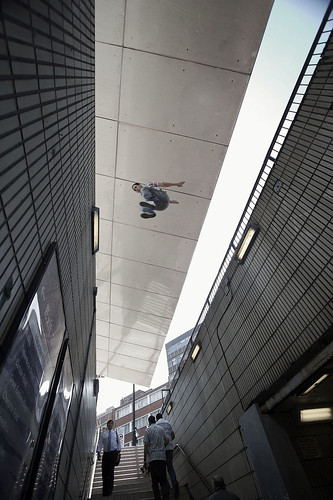
http://www.flickr.com/photos/jonlucas/
Parkour is a kind of structure-surfing action where participants find new ways to maneuver through diverse largely urban architectures doing anything but walking on the street. This appears to me to be a kind of classic, side-scroller video game play action executed in the physical world. For the purposes of giving some meaning to it in the context of new interfaces for digital play we might speculate that it is an expression of that dynamic, hop-jump-climb action of things like Super Mario Bros. and the like. Manuevering through a diverse landscape of architectural affordances for the simple set of “physical” actions your Mario game avatar has at his disposal. Only, instead of playing exclusively on the screen, sitting still somewhere, you turn the real world landscape into one “playable” like a video game.
The insight here is that it is no surprise that the real world looks like a video game to the digital kids who grew up with them. And, further, that experiencing video game worlds creates a template in ones mind that overlays other real-world experiences — the world and the things we do in it take on the meaning, systems and symbols — the idioms — of video games. The ritual of video game practices becomes the window through which we see and experience the world. This may be a weak signal for new kinds of playful interfaces that happen away from the canonical fixed-screen interface.
Now, I’m not making any sort of normative assessment here as to whether or not this is a good thing. What I am hopeful for is the possibility for extending some of the digital networked worlds’ social rituals into mixed, hybrid experiences. At least the social interaction rituals that seem to make for a more playful, habitable world. For that, you need new kinds of interfaces for interaction and new channels through which to circulate action. This is one of the reasons the Near Future Laboratory has focused so heavily on curious and sometimes preposterous interface devices that use non-keyboard-video-mouse interactions.
